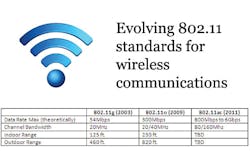As a teaser to the 2012 Consumer Electronics Show (CES) back in January, Broadcom – a semiconductor solutions company specializing in wired and wireless networks – announced what's believed to be the first chipsets in the 802.11ac standard, the newest addition to the 802.11 portfolio. Broadcom promises Gigabit wireless speeds, and has dubbed this "5G Wi-Fi." Other wireless networking companies like Buffalo Technologies and Redpine Signals announced their "ac" plans on the CES show floor as well.
So how different is the 802.11ac standard from its predecessors? And, given that 4G has been available in the market for a couple of years, what impact will the two technologies have on physical security practitioners?
To make predictions we first need to step back in time. In February 2011, I wrote an article for SecurityInfoWatch.com about 802.11n wireless, the then-newest 802.11 standard issued by IEEE. In that article I explained that the 802.11n standard provided an increase of up to 400 percent in available bandwidth and doubled the transmission range. These increases opened new doors for the deployment of physical security applications in areas that were traditionally cost prohibitive or technically infeasible. For instance, prior to the new standard, deploying HDTV cameras in a large parking lot was technically feasible but rarely used due to high cost. Today, 802.11n and the corresponding devices not only provide the necessary bandwidth and range to operate high-resolution cameras, but camera manufacturers are now offering truly cost-effective HDTV cameras rated for outdoor use.
As we predicted, 2011 saw the proliferation of 802.11n products flooding both the consumer and commercial markets – everything from smart phones and tablets to televisions and commercial-grade wireless connectivity. Conversely, camera manufacturers only introduced a handful of 802.11n-compatible surveillance cameras to the marketplace, limiting consumers to a few entry level solutions. Even so, security practitioners leveraged 802.11n by pairing wireless access points to professional-level cameras. Last year we saw the deployment of 802.11n IP-based surveillance systems in retail, transportation and, most notably, in municipal monitoring applications.
While still in its infancy inside the security world, 802.11n has been a game changer with increasing returns that affords practitioners with a host of options they never had before.
More is better: 802.11ac
In January of 2011, the IEEE announced the initial technical specification for 802.11ac, which drove bandwidth into the Gigabit-per-second range. Using multiple-input, multiple-output (MIMO) data communication, which incorporates multiple antennas for sending and receiving data, 802.11ac bandwidth ranges from 800Mbps up to 6Gbps. Like its predecessors, the latest standard operates below the 6GHz spectrum but increases channel width from 40MHz up to 160MHz, which theoretically increases bandwidth by 900 percent over 802.11n (Remember: 802.11n increased bandwidth by 400 percent times over its previous ancestor).
802.11ac is expected to be ratified in late 2012, but that hasn't stopped manufactures like Broadcom from producing chipsets based on its specifications. I expect that within a year, the consumer market will see companies launching wireless access points geared towards the residential or SOHO (small office, home office) markets. However, I don't anticipate this technology being adopted in the commercial sector until 2013.
This doesn't mean that consultants and integrators should dismiss the technology's viability as too far in the future. Remember that consultants and integrators often work on projects with roll-out schedules that span several years. Since these standards are backwards compatible, integrators can install successive iterations of the technology to improve performance without sacrificing the existing installed base.
Let's take a quick look at the evolution of these standards and their impact on the data bit rate, channel bandwidth and range:
802.11g (2003)
Data Rate Max (theoretical): 54Mbps
Channel Bandwidth: 20MHz
Indoor Range: 125 ft.
Outdoor Range: 460 ft.
802.11n (2009)
Data Rate Max (theoretical): 300Mbps
Channel Bandwidth: 20/40MHz
Indoor Range: 230 ft.
Outdoor Range: 820 ft.
802.11ac (2011/2012)
Data Rate Max (theoretical): 800Mbps to 6Gbps
Channel Bandwidth: 80/160Mhz
Indoor Range: TBD
Outdoor Range: TBD
Life in the 4G lane
In July of 2010 the 4G revolution in the mobile phone world was in full marketing swing with the big three providers – AT&T, Verizon and Sprint – claiming dominance. With 4G came competing technology standards vying for the carrier business: Long Term Evolution (LTE) and Worldwide Interoperability for Microwave Access (WiMAX). In July 2010, we covered trends in 4G mobile bandwidth technologies with, IT Trends Impacting IP Video: 4G Network Standards.
In that article we explored the differences between the competing standards as well as the implications they had for physical security and video surveillance. If you compare their deployments since 2010, LTE has clearly won the standards battle and become the technology of choice used in 4G networks, thanks in large part to the backing of Verizon and AT&T. Promising specified download speeds of up to 100Mbps and upload speeds of 50Mbps, LTE offered a unique wireless solution for security professionals. With bandwidth approaching Local Area Network (LAN) speeds without being tied to a specific geographical area, security professionals could deploy IP surveillance cameras anywhere they could get bars on their phone.
Its almost two years later and the three main providers continue to rollout 4G networks with limited coverage across the US. Verizon has reached more than 100 metropolitan areas with LTE. Sprint, with its WiMAX technology, comes in a close second – although the company recently announced that they, too, will begin rolling out LTE services in 2012. AT&T comes in a distant third, only offering LTE service in 20+ metropolitan areas (as of February 2012).
Despite the capabilities defined in the LTE standard, the reality is far from what was specified. The three providers offer similar plans that cap bandwidth between 5 to 12 Mbps – disappointingly, a far cry from the specified 100Mbps. There are also download/upload plans that cap out at around 10 Gigabytes. Of course you can download more, but at a cost of $10 USD per Gigabyte, this option is effectively cost-prohibitive for most security managers.
Yet savvy systems integrators can leverage LTE for task-specific solutions by understanding some of the advanced features available on network cameras. Bandwidth consumption can be limited by enabling intelligent video functions within the camera or encoder. With intelligent functions such as video Motion detection, active tamper alarms and cross line detection residing at the edge (i.e. in the camera), video is only transmitted over the wireless network when a condition is met, such as on motion detection, if the camera is obstructed or moved, or when a person crosses a virtual line in the scene. This way, the customer is not paying for video transmission unless there is a recordable event.
Onboard storage opens up even more opportunities by giving the customer the option of recording at a higher quality level in the camera while transmitting video wirelessly at a lower quality to reduce bandwidth consumption. For instance, by combining 4G data transmission and onboard storage, a security officer could receive an alert from a camera that has detected motion. He could view the video on his workstation or mobile device in VGA resolution streaming four frames per second to see that someone is clearly breaking into a store. While police are dispatched to the scene, the higher resolution and frame rate video stored in the local recording device (i.e. the SD card) can be used for the investigation, and then again as forensic detail in court prosecution. Depending on the camera settings and how long the guard actively observes the scene, this situation could play out hundreds of times per month before hitting the 10GB limit included in the monthly fee assessed by wireless carriers.
When it comes to new standards, pace yourself
It's safe to say that the wireless technology trends in the IT and consumer worlds will continue to present new opportunities and challenges for security professionals as the shift to IP continues. It may feel like it's a constant struggle to keep up with the latest and greatest proposed standards – but once you realize that each new standard takes time to permeate the market, you'll find that the technology treadmill is not such a rat race after all.
About the author: James Marcella has been a technologist in the security and IT industries for more than 18 years. He is currently the Director of Technical Services for Axis Communications.



